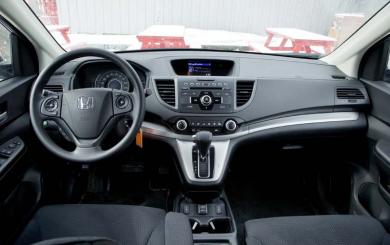  2013 Honda CR-V LX AWD vs. 2013 Toyota RAV4 XLE FWD. Click image to enlarge |
Review by Jonathan Yarkony, photos by Jeff Wilson and Jonathan Yarkony
Originally published April 15, 2013
After several months in an Autos.ca Long-Term Test, a Test Drive last year and surviving three Comparison Tests (and winning one) we are plenty familiar with Honda’s CR-V. The Toyota RAV4, on the other hand, is new to the market just this spring and both dramatically changes from the previous generation while in some ways returns to its roots.
Both are now exclusively five-seat, four-cylinder, soft-roader crossover SUVs with optional AWD, just as they were when these nameplates were launched in the mid-nineties (okay, the RAV4 had those ridiculous two-door and convertible models, but lets just conveniently ignore those for the sake of symmetry, here). Both are also built in Canada, though that was not as significant a factor in their comparison as the fact that they have consistently battled in the sales charts, fighting for compact SUV shoppers that didn’t opt for the dominant Ford Escape. While the Escape dominates the Canadian compact SUV sales charts, the CR-V topped it in the States with over 280,000 units sold, but this year is trailing both the Escape and RAV4 in Canadian and American sales.
While we aim to have a more extensive comparison with new compact crossover offerings later this summer, we felt that these two have such a similar history and approach that we wanted to see how these traditional rivals (perhaps even ‘icons’ of the crossover breed) stacked up head to head. And despite a slight mismatch in trims, we feel that the essential qualities of each vehicle were present and accounted for, enough so that a fair and relevant evaluation can be conducted even with the varied option selections offering differences in character that serve to highlight the strengths of each vehicle and brand.
Features/Value:
We were able to book an almost identically priced RAV4 during one of the last weeks of the CR-V’s residence, although they were not nearly identically equipped. Our CR-V is essentially a base model LX with one big feature, AWD, added on, taking the price to $28,140, plus a $1,640 destination fee and $100 excise tax for a grand total of $29,880.
The RAV4 we were offered came to $29,905, the difference less than the price of a family meal at Swiss Chalet. However, it arrives at that price over the base $23,790 LE FWD (score a point for Toyota for this low base price) as the $27,000 FWD XLE, $1,170 for the nav system (plus XM satellite radio and voice command), plus $1,635 destination and $100 A/C tax landing it at $29,905. For the equivalent of the CR-V’s base price ($25,990), the RAV4 can be had with AWD.
  2013 Honda CR-V LX AWD & 2013 Toyota RAV4 XLE FWD. Click image to enlarge |
Feature for feature, Honda at least has a slight edge in base-model equipment with an LCD display screen with radio data, voice command, driver armrest (vs a shared centre console armrest in the RAV4), a compass, heated driver and passenger seats, and a back-up camera. The RAV4 has wheel covers, which the CR-V does not.
However, in this specific comparison, the RAV4 XLE FWD bumps the speaker count to six (from four), adds a sunroof, alloy wheels, dual-zone auto climate, 6.1-inch touchscreen display, heated front seats and premium cloth, cargo cover, variable intermittent wipers and a back-up camera, as well as the aforementioned nav system upgrade that also includes XM satellite radio and voice command. Without going all the way up to XLE trim, you can get the 6 speakers, 6.1-inch touchscreen display, tinted windows, cargo cover and back-up camera as a $1,000 upgrade package on the FWD or AWD LE trim.
Without question, the RAV4 provides more features at a better price.














